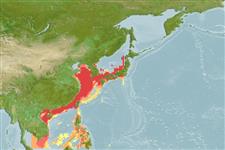分类 / Names
俗名 | 同种异名 | Catalog of Fishes(属, 种) | ITIS | CoL | WoRMS | Cloffa
Elasmobranchii
板鳃亚纲 (鲨鱼与 鱼) (sharks and rays) >
Orectolobiformes (Carpet sharks) >
Orectolobidae (Carpet or nurse sharks)
Etymology: Orectolobus: orektos (Gr.), stretched out; lobus (L.), from lobos (Gr.), rounded projection or protuberance, referring to long nasal barbels of Squalus barbatus (=O. maculatus). (See ETYFish); japonicus: -icus (L.), belonging to: Japan, described from two specimens, both from Japan. (See ETYFish).
More on author: Regan.
Environment: milieu / climate zone / depth range / distribution range
生态学
海洋 居于水底的; 深度上下限 0 - 200 m (Ref. 106604). 熱帶; 43°N - 6°N, 103°E - 140°E
Western Pacific: Japan and Korea to Viet Nam.
西太平洋: 日本與韓國到越南與菲律賓。
Length at first maturity / 大小 / 重量 / 年龄
Maturity: Lm ?, range 103 - ? cm
Max length : 118 cm TL 雄鱼/尚未辨别雌雄; (Ref. 106604)
简单描述
检索表 | 型态特徵 | 形态测量图
背棘 (总数) : 0; 臀棘: 0. Five to six dermal flaps below and in front of eyes; back with light areas between dark saddles marked with broad reticulated dark lines (Ref. 13577). Caudal fin with its upper lobe hardly elevated above the body axis, with a strong terminal lobe and subterminal notch but no ventral lobe (Ref. 13577).
在眼下面与前面的五到六个皮芽; 背面有在黑的鞍状标记之间的淡色区域有宽的网状黑色线条.(参考文献 13577) 尾鳍上叶并不高的上方体轴, 具有一个强韧的端叶与接近端位的凹槽但是没有腹的叶.(参考文献 13577)
A little-known bottom shark found inshore (Ref. 247); usually in sand or sandy mud bottoms (Ref. 11230); also on rocky and coral reefs (Ref. 43278). Nocturnal in habits (Ref. 247). Feeds on fish and presumably bottom invertebrates (Ref. 247), including lizardfishes, cutlassfish, horse mackerel and other jacks, goatfishes, groupers, tilefishes, sea robins, whiting, parrotfishes, sea bream, croakers, also skates, shark egg cases, cephalopods, and shrimp (Ref. 43278). Ovoviviparous (Ref. 43278, 50449), with up to 20 young in a litter (Ref. 247). Wobbegongs should be regarded as potentially dangerous because of its formidable dentition (Ref. 247, 13577). Used for human consumption (Ref. 247). Kept in aquaria in Japan and the United States (Ref. 43278).
所知极少的底栖鲨鱼发现沿海地区;(参考文献 247) 通常在沙子或沙泥底;(参考文献 11230) 也在岩石与珊瑚礁上.(参考文献 43278) 夜行性.(参考文献 247) 捕食鱼类, 与可能底栖无脊椎动物.(参考文献 247) 卵胎生的 (参考文献 50449), 多达 20 幼鱼在一胎.(参考文献 247)。 须鲨应该被视为可能危险由于它的强大生齿.(参考文献 247,13577) 供人类消费使用.(参考文献 247) 在日本与美国保存于水族馆了。 (参考文献 43278)
Life cycle and mating behavior
Maturities | 繁殖 | Spawnings | Egg(s) | Fecundities | 仔鱼
Ovoviviparous, embryos feed solely on yolk (Ref. 50449). With up to 20 young in a litter (Ref. 247).西太平洋: 日本與韓國到越南與菲律賓。
Compagno, L.J.V., 1984. FAO Species Catalogue. Vol. 4. Sharks of the world. An annotated and illustrated catalogue of shark species known to date. Part 1 - Hexanchiformes to Lamniformes. FAO Fish. Synop. 125(4/1):1-249. Rome, FAO. (Ref. 247)
人类利用
渔业: 低经济
工具
特别资料
下载 XML
网络资源
Estimates based on models
Preferred temperature (Ref.
123201): 14.5 - 27.7, mean 24 °C (based on 222 cells).
Phylogenetic diversity index (Ref.
82804): PD
50 = 0.5012 [Uniqueness, from 0.5 = low to 2.0 = high].
Bayesian length-weight: a=0.00389 (0.00180 - 0.00842), b=3.12 (2.94 - 3.30), in cm total length, based on all LWR estimates for this body shape (Ref.
93245).
营养阶层 (Ref.
69278): 3.8 ±0.57 se; based on food items.
回复力 (Ref.
120179): 低的, 最小族群倍增时间4.5 - 14 年 (Fec=20).
Fishing Vulnerability (Ref.
59153): High to very high vulnerability (71 of 100).
